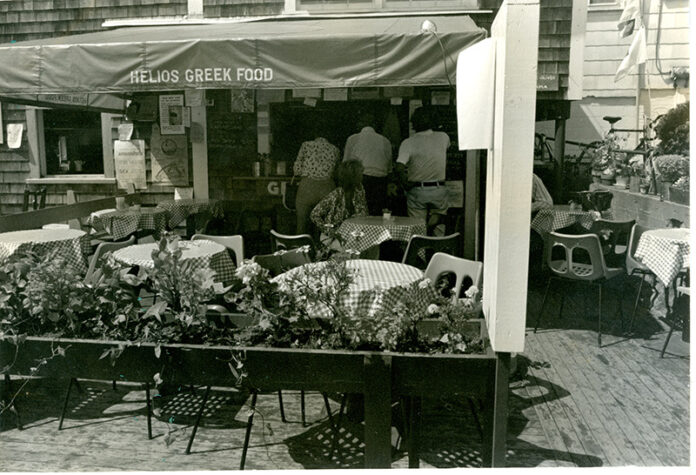It was January in 1976, the coldest day of the year, and Doug Thatcher was just glad that he was inside where it was warm, and not outside like he had been for the past several months, pounding nails, helping to build the new Helios restaurant. It was opening day for Helios, which had just relocated to the old Nobnocket garage site in Vineyard Haven, more or less across State Road from Crane Appliance. Today, where once stood a large building with a corrugated roof, a faux Western façade, and an outside patio, there is just scrub oak, poison ivy, and memories of a bygone era.
Helios occupied a singular place in Martha’s Vineyard restaurant lore, a place where art, dining, and belly dancing intersected, a place that was a part of the Vineyard’s coming of age in the Seventies, a restaurant for the Age of Aquarius. As Doug Thatcher, a former manager at Helios said, it represented a sea change on the Island.
To understand Helios, you have to understand Lucia Moffet and Bill Prokos, who started Helios. Lucia Evans Moffett grew up in Ohio, but after spending a year abroad studying at the Sorbonne, she developed a love of things French. Yet she will always be remembered on the Vineyard as the owner of a Greek restaurant.
In the early Sixties, Moffet was teaching French in New York and living in Greenwich Village, when she met a fun-loving and talented illustrator named Bill Prokos who grew up in a Greek family, cooking Greek food.
Prokos was working on illustrating science texts, and the publisher, W.A. Benjamin, brought him to the Vineyard in the summer of 1968; he and Moffet fell in love with the Island. Keep in mind that the Vineyard in the late Sixties and early Seventies bore little resemblance to the Vineyard of today. As George Brush of West Tisbury somewhat facetiously put it, “In the off-season you could get a grilled hotdog at the bowling alley or a pickled egg at the Ritz, but that was about it.”
But around 1968, Bill and Lucia found a commercial outlet for their Greek cooking and set up a stand at the Martha’s Vineyard Agricultural Fair. Joe Hall of Vineyard Haven — who would be involved with Helios over the years — recalled that they went through 30 legs of lamb for shish kabobs in just a few days at the fair.
And then the Black Dog Tavern opened in 1971, and Prokos and Moffet soon found themselves hosting the very popular Greek theme nights there, complete with Greek food and dancing.
Building off their success at the Black Dog, Bill and Lucia took this as a sign, and in 1971 (although everyone’s memory is a little foggy when it comes to exact dates) they opened up a hole-in-the-wall cafe in Edgartown below the Robert de Paris beauty parlor, in the location where Among the Flowers Cafe is today. They called the cafe Helios, after the god of the sun in Greek mythology.
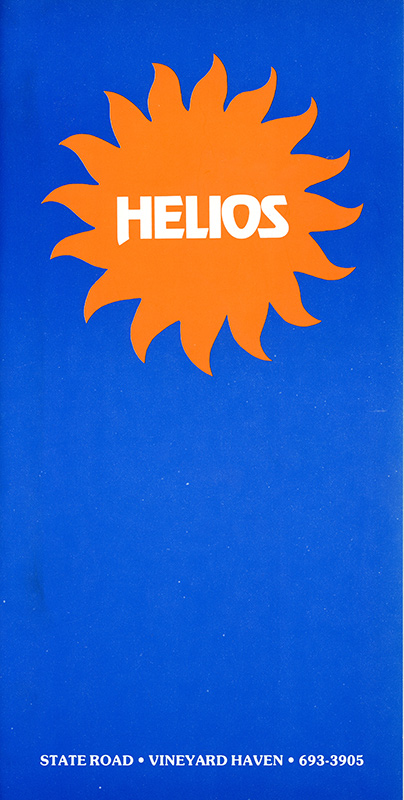
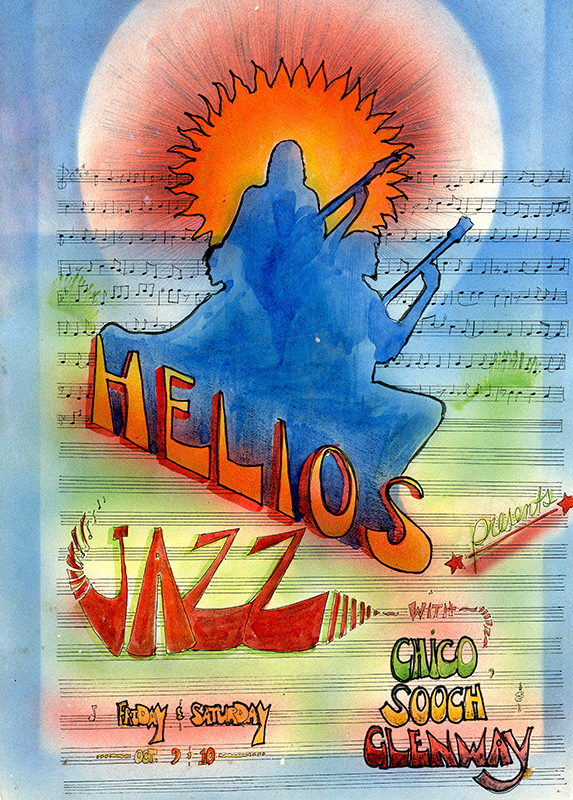
The Edgartown Helios
Claudia Canardy Lee, owner of Claudia’s jewelry shops in Edgartown and Vineyard Haven, remembers being in Edgartown the summer when Helios opened; she found herself going to the cafe most every night — it was a great place to hang out and meet people. The La Cimbali espresso machine was also a big draw, allegedly the first one on the Island.
Lucy Mitchell of West Tisbury helped cook and bake at Helios, and remembers it having a simple Greek menu, some outside tables, and being extremely cramped. It was so small that they would do the cooking and baking at the home of their friends, John and Cappy Hall, and at the Youth Hostel kitchen. “Bill was an avid fisherman,” Mitchell said,“and he would grill up freshly caught bluefish, striped bass, and shish kabobs on a hibachi in the alley.”
Emily Bramhall of Chilmark, executive director of the Permanent Endowment (and formerly the owner of Bramhall & Dunn in Vineyard Haven), remembers that she started working at Helios when she was 12. She was particularly fond of the Super Helios sandwich — homemade pita bread sliced open and filled with sliced veggies, feta cheese, and lamb or beef. “Lucia had an adherence to fresh, healthy food,” Bramhall said. “What she was doing then would be very accepted today. It was wonderful, just good fresh food. People came down every day for a slice of cake and Turkish coffee … it was never really expensive.”
Unfortunately, Helios was a little too successful. Robert de Paris, their landlord, decided he should raise the rent, which essentially put Helios out of business — but as they say, as one door closes, another opens up.

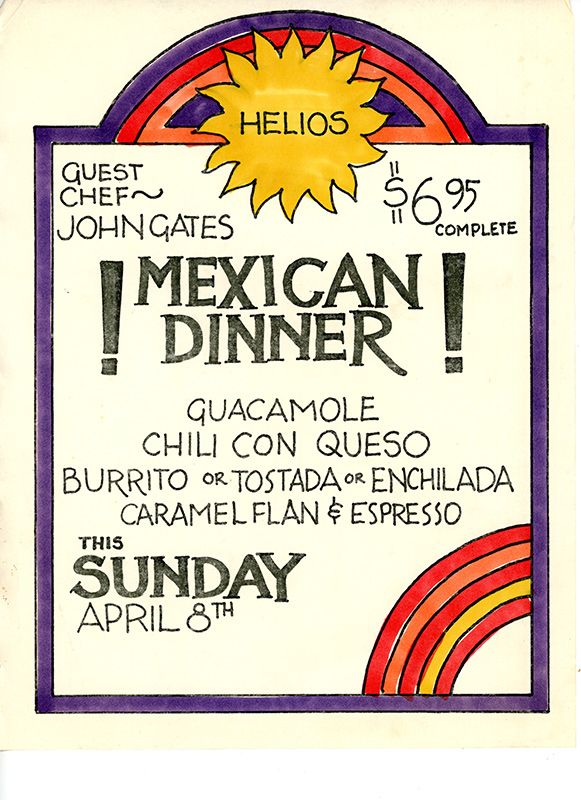
Art Workers Guild
In the early Seventies, James Taylor built the Nobnocket garage on State Road in Vineyard Haven to help out his friend John Parkinson set up a car repair shop. After a couple of years, the garage failed, but coincidentally a group of artists and craftspeople were looking for a place to work. Julia Mitchell (Lucy’s sister), a weaver who incidentally also worked at Helios, said she was friends with Bill Honey, who worked at the Martha’s Vineyard National Bank, and Honey told her about the Nobnocket space.
What’s more, he told Mitchell that there had been an organization called the Art Workers Guild on the Island in the Thirties, and if the group incorporated, they could assume the mantle of the Art Workers Guild. Mitchell said that “someone approached Parkinson about taking over the Nobnocket space, and all Parkinson allegedly had to say was, ‘Sure, as long as there are no swastikas.’”
Soon, some of the Island’s finest artists and craftspeople, such as Doug Kent, Travis Tuck, Julia and Lucy Mitchell, Anna Edey, Robbie McGregor, Thaw Malin, and Kib Bramhall, began showing at Nobnocket — woodworkers, boatbuilders, weavers, potters, glassblowers, painters; Jeanne DelGiudice made marionettes.
Artist Robbie McGregor said he was one of the first people to actually live at Nobnocket. For heat, he cut a hole through the wall to run a stovepipe out. Within a year, he said, there were stovepipes everywhere. He laughs thinking about a time when you could do something like that without permits. Again, it was the Seventies.
Helios Vineyard Haven
So when Helios in Edgartown was forced to close, Bill and Lucia saw Nobnocket as a great place to reopen. In addition to his culinary talents, Bill Prokos was also a carpenter, so in the fall of ’75 he enlisted the help of Doug Thatcher, Joe Hall, Emily Bramhall, and others to build out a restaurant adjoining the Art Workers Guild. “I learned a little carpentry at the Putney School in Vermont,” Bramhall said, but Bill and Lucia were firm believers in giving people all the responsibility they could handle, and the restaurant opened in January of ’76.
Joe Hall, who would become general manager of Helios, said perhaps the best thing the new Helios had going for it was timing. The Black Dog Tavern closed down the first winter that Helios opened. ”We probably got twice the business we normally would have had because of that,” Hall said.
He also said that Bill and Lucia approached the venture with a certain innocence and naiveté. “There was never really a business plan. Bill and Lucia didn’t really approach it as a business, they just wanted to enjoy what they were doing … it was more about finding compatible people than making a profit.”
In fact much of the charm of Helios came from the fact that everyone who worked there was considered family. Lucy Mitchell said that feeling came from Lucia: “Her magnetism made everybody feel like they were crucially important to the team … she had such a lovely way about her.”
“Lucia was saintly,” Julia Mitchell said. “Loyalty is what she did best — everyone adored her.”
“The first winter, Lucia and Bill went to Greece and left me with the checkbook,” Bramhall said. “Lucia just said pay the employees first, then the vendors … at least give them something. I feel like my college education came from Helios.”
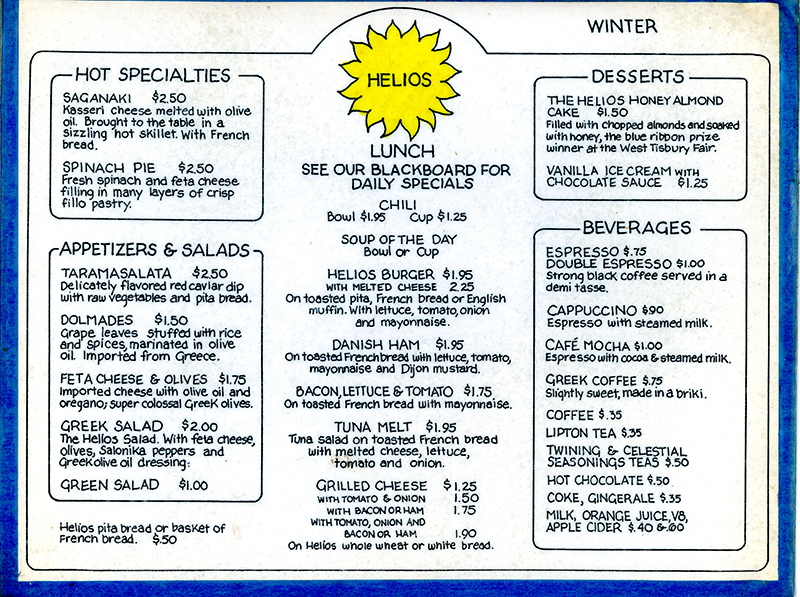
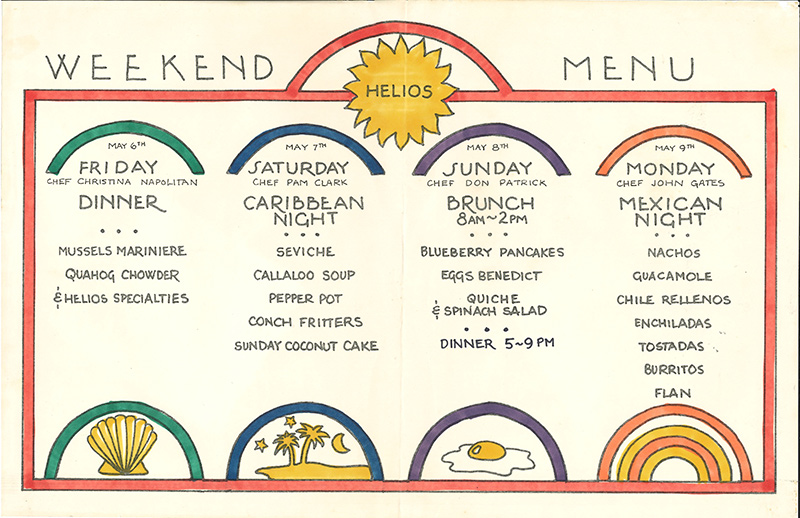
Julia Mitchell was not only a chef at Helios, she was also a founding member of the Art Workers Guild. “I’d prep in the morning,” she said, “work at the Guild in the afternoon, be back at Helios in the evening, and then sleep in my space at the Guild at night.” Julia describes the culture at Helios as very egalitarian, not hierarchical. “Everyone was very vocal, they wanted to do it their own way, it was the Seventies [How many times did I hear this?],” she said. “Every once in a while I had to put my foot down, but everyone loved each other.”
Julia said that the whole operation was very loose, and that you had to be able to think on your feet. ”Every so often someone would bring in a 30-pound striped bass and we would have to prepare it. Actually that was the bane of my existence.”
“The wait staff were essentially all amateurs,“ said Janet Messineo of Vineyard Haven. “I had worked at the Black Dog and the Home Port, so they made me head waitress. I’d make schedules, but honestly there were waitresses who didn’t need to work, and they’d say, ‘I can’t work Thursday because I have a yoga class’ or an art lesson, so I put a sign in the kitchen that said, ‘This is a job, not a hobby,’ and if they didn’t show up I’d fill in, but fortunately it was a lot of fun.”
The family concept extended to the customers as well. There were guest chef nights. If someone had a special recipe, Bill would put it on the menu with the contributor’s name on it. “The atmosphere was extremely relaxed and informal,” Doug Thatcher said. “It would be difficult to duplicate today when people just don’t have the time to hang out and be involved.”
“There was a darts tournament,” Emily Bramhall said.
“Sometimes we’d just go there to have an espresso and play backgammon,” Wendy Whipple of West Tisbury said.
“I remember sometimes they’d have a magician,” Laurie Miller, a member of the Art Workers Guild, said. “He’d drive you nuts when you were trying to eat dinner.”
“Diane Hartman was a belly dancer at Helios,” Janet Messineo said. “She’d often dance at dinner, and sometimes she’d dance after hours — there was a pretty big after-hours scene.”
An old friend of Lucia’s, the Irish musician David O’Docherty, would often play songs on his pennywhistle.
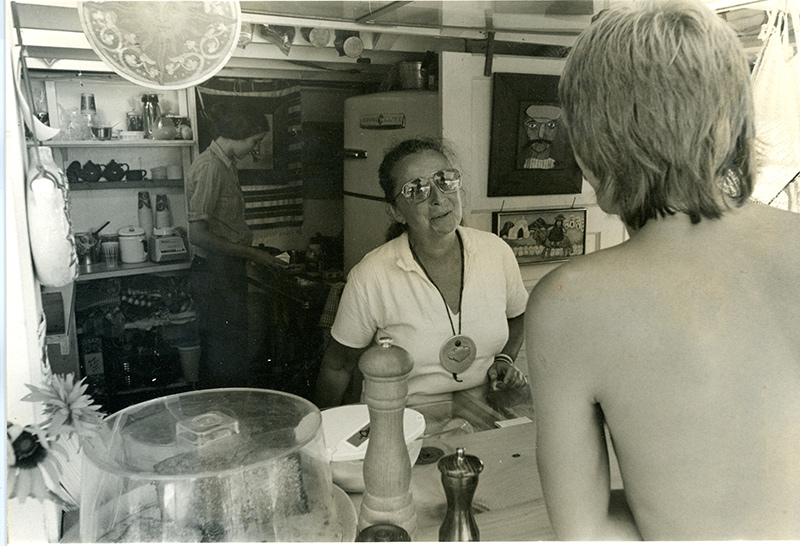
The customers at Helios ran the gamut of Vineyard life in the Seventies. There was a regular table for members of the Art Workers Guild, as well as a good sampling of the Vineyard celebrities of the moment. “I remember waiting on Beverly Sills one time, and another time I waited on James and Carly and John Travolta,” Messineo said. “Travolta was Vinnie Barbarino from ‘Welcome Back, Kotter’ at the time. My adrenaline was really pumping.”
“Lillian [Hellman] used to come in with her jar full of martinis,” Joe Hall said, and since Susanna Styron worked at Helios, her parents, William and Rose Styron, were frequent customers.
“People just felt part of the family when it came to Helios,” Hall said. “Bill always had a bottle of ouzo on hand which he liked to share with customers, and if sometimes the food took too long to arrive, no one cared, they were having so much fun.”
The Art Workers Guild dissolved in the late Seventies, and Helios closed its doors a few years later. Bill Prokos became sick with cancer, and died in 1977, not long after Helios opened in Vineyard Haven. After Prokos’ death, Lucia married George Moffet and split her time between the Vineyard, New York, and Ireland. While everyone agreed that things were never quite the same without Bill and Lucia, the two had nonetheless built a sustainable culture at the restaurant that lived on. And since the closing of Helios, there has never been anything to take its place.
Sandy Fisher of West Tisbury organized the memorial service for Lucia, who died in 2015. “She was the most wonderful human being I’ve ever met in my life,” Fisher said, “and she was brilliant.”
“We don’t hang out the same way anymore,” Claudia Canardy said. “I feel bad for our kids; there’s no place like Helios around for them to go to today.”
And Joe Hall wrote me an email that spoke volumes to the place Helios occupied on the Island. He was paraphrasing Katy Suval, who once worked at Helios. “She said, ‘We didn’t really know how good it was, what a perfect place it was to work, with wonderful people … so that wherever or whenever we worked later in our lives, it was never going to match the experiences we all had at Helios.’”
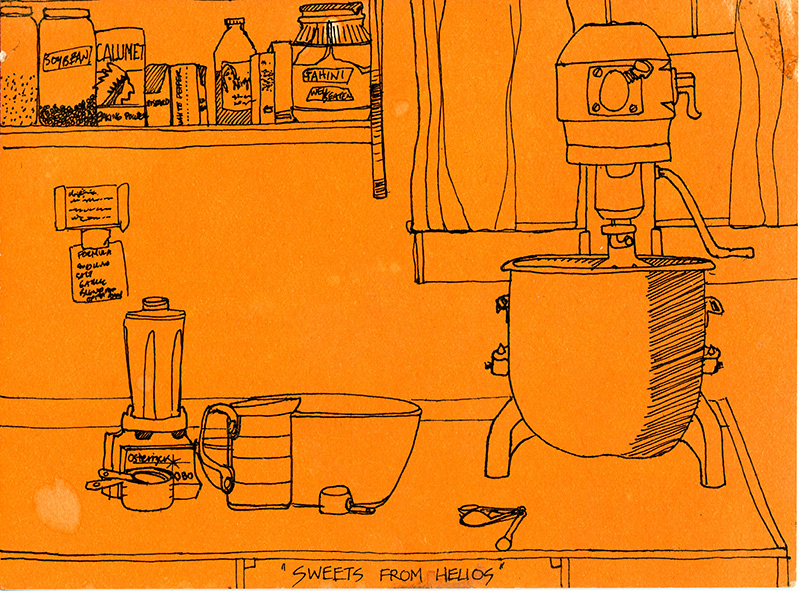
Recipes
These are some classic recipes Julia Mitchell once prepared at Helios; she still swears by them today.
Helios Spanakopita
Makes 1 large spinach pie
2 large or 3 medium onions, chopped 2½ sticks unsalted butter 4 eggs, beaten 3 bags spinach, washed, spun dry, and chopped coarsely 4 cups cottage cheese 4 cups ricotta cheese 2 packages feta cheese, crumbled 1 cup fresh dill, or more, chopped 1 tsp. grated nutmeg freshly ground black pepper 1 to 2 boxes fillo dough, defrosted overnight in refrigerator
Preheat oven to 375°F. Sauté onions in ½ stick butter until soft but not browned. Cool. In a large bowl combine eggs, cooled onions, spinach, 3 cheeses, dill, nutmeg and pepper.
Melt remaining 2 sticks butter. Line large roasting pan with layers of fillo, brushing melted butter between layers, until you have eight layers. Add spinach filling, and level off. Top with 10 to 12 more layers of fillo, tucking in the edges carefully when done.
Carefully score the top couple of layers of fillo into squares about 3 in. by 3 in. or so. Don’t cut all the way through the fillo.
Bake for about 45 minutes or until nicely golden, sizzling, and puffed. Let sit 10 minutes before cutting.
Helios Moussaka
For 2 large moussaka
Meat sauce:
2 medium white onions, chopped 6 Tbsp. butter 10 lbs. ground beef 4 12-oz. cans tomato paste 4 cups good red wine 1 large bunch parsley, chopped ¼ cup cinnamon
Cream sauce:
2 cups butter (1 lb.) 1½ cups flour 4 quarts whole milk 8 cups whole milk ricotta cheese 1 tsp. freshly grated nutmeg 16 eggs 8 large, fresh eggplant olive oil Grated Parmesan cheese, optional
Slice the eggplants crosswise into ½ – ⅝-in. rounds. Arrange them on layers of paper towels, salting each layer. Put a weight on top of the pile and let eggplant drain of its excess water while you make the meat sauce.
Meat sauce:
Sauté onions slowly in butter until soft but not at all browned.
Sauté meat, 5 pounds at a time, in a large skillet, stirring occasionally, until no longer pink. Drain fat off completely and discard. Put meat into a big pot, and add sautéed onions. Combine tomato paste and red wine and blend. Add to pot along with the rest of the meat sauce ingredients, and salt and pepper to taste. Bring all to a boil, and simmer gently while you prepare the cream sauce.
Cream sauce:
Melt butter in a large pot. Add flour and make a roux, cooking and stirring for at least 3 minutes to cook the flour.
Scald the whole milk and add gradually to roux, whisking all the while, until smooth and thick. Remove from heat. Add ricotta, nutmeg, and salt and pepper to taste.
Beat eggs well and add, mixing all together thoroughly. Adjust seasonings if necessary.
Eggplant:
Pat eggplant slices dry.
Oil 2 large sheet pans with olive oil and make single layers of eggplant and brush tops of eggplant with a little olive oil.
Broil eggplant until golden brown and soft. Remove and replace with more eggplant, brushing with olive oil and repeating the broiling until all the eggplant is cooked.
Preheat oven to 350°F.
Brush 2 large roasting pans with olive oil, and line each pan with ¼ of the broiled eggplant.
Divide the meat sauce evenly between the two pans, distributing it evenly over the eggplant layer and flattening it on top.
Top meat sauce with remaining eggplant, ¼ in each pan.
Pour cream sauce on top, dividing evenly.
Sprinkle a little Parmesan cheese on top, if desired.
Bake for about an hour until the cream sauce is golden and bubbly, and has firmed up. When done, let sit for at least half an hour before cutting.
Helios Baklava
Makes 4 large sheet pans
Syrup:
6 cups sugar 6 cups water 1 cinnamon stick or 1 tsp. ground cinnamon a few cloves 3 or 4 lemon slices 1 cup honey (pref. Greek)
Bring to boil and cook first 5 ingredients for about 10 minutes. Remove from heat, and stir in honey. Cool completely before making baklava.
Baklava:
16 cups walnuts, finely ground 8 cups almonds, finely ground 2½ cups sugar ⅓ cup cinnamon 2 Tbsp. nutmeg 4 tsp. ground cloves about 60 sheets fillo (4 boxes? Not sure. Read the fillo box) unsalted butter (2 pounds? More?) Whole cloves
Combine finely ground nuts with sugar and spices.
Preheat oven to 325 degrees F. Butter 4 big, shallow sheet pans. Use 2 sheets fillo to make a single layer in each pan, and brush with melted butter. Repeat eight times.
Evenly spread 2 cups nut mixture in each pan, and sprinkle with some melted butter. Make 4 more layers of fillo in each pan as before.
Repeat nut mixture and melted butter layer. Repeat 4 layers fillo layer.
Repeat nut mixture and melted butter layer. Top with 12 layers fillo and butter, laying final layers extra-carefully, as they will be the ones to show.
Tuck in excess fillo carefully.
Score top 2 or 3 fillo layers into diamond shapes, maybe 1½ in. by 1½ in. (or smaller?), and stud each piece with a whole clove. Bake until dark golden.
As soon as it comes out of the oven, pour COLD syrup carefully over all, until you can see syrup settling in the pan around the edges.
NOTE: Add COLD syrup to HOT baklava, or HOT syrup to COLD baklava.
















